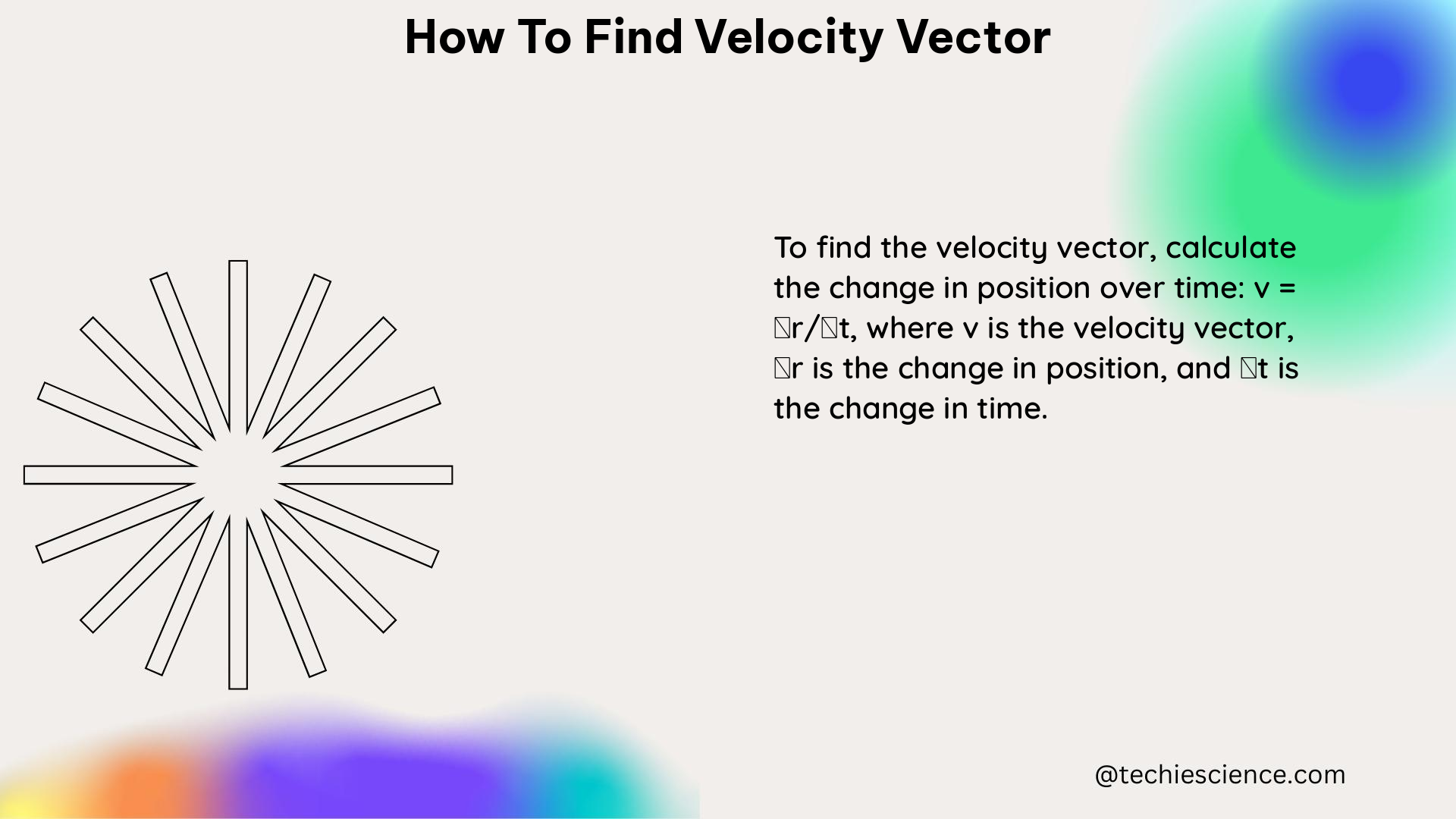Velocity is a fundamental concept in physics, describing the rate of change in an object’s position over time. The velocity vector, in particular, provides a complete representation of an object’s motion, including both its speed and direction. Understanding how to accurately determine the velocity vector is crucial for various applications in physics, engineering, and beyond. In this comprehensive guide, we will delve into the intricacies of finding the velocity vector, equipping you with the necessary knowledge and tools to master this essential skill.
Understanding the Velocity Vector
The velocity vector, denoted as v⃗, is a vector quantity that represents the direction and magnitude of an object’s motion. It is defined as the derivative of the position vector r⃗ with respect to time:
v⃗(t) = r⃗'(t) = x'(t) * î + y'(t) * ĵ + z'(t) * k̂
where x'(t), y'(t), and z'(t) are the components of the velocity vector in the respective x, y, and z directions, and î, ĵ, and k̂ are the unit vectors in those directions.
The magnitude of the velocity vector, known as the speed, is calculated as:
speed = |v⃗(t)| = √(v_x(t)^2 + v_y(t)^2 + v_z(t)^2)
where v_x(t), v_y(t), and v_z(t) are the components of the velocity vector.
Calculating the Velocity Vector

To find the velocity vector, you need to know the speed and direction of the object’s motion. The velocity vector can be calculated using the formula:
v⃗ = v * (cosθ * î + sinθ * ĵ)
where v is the speed, θ is the angle of motion with respect to the x-axis, and î and ĵ are the unit vectors in the x and y directions, respectively.
Example 1: Calculating the Velocity Vector from Speed and Direction
Suppose an object is moving at a speed of 7 km/h in the direction of -6i + j. To find the velocity vector, follow these steps:
-
Calculate the magnitude of the direction vector:
|-6i + j| = √((-6)^2 + (1)^2) = √36 + 1 = √37 ≈ 6.08276 -
Find the velocity vector by multiplying the unit vector in the direction of motion by the speed divided by the magnitude of the direction vector:
v⃗ = 7 km/h * ((-6/6.08276) * î + (1/6.08276) * ĵ) ≈ 4.2 î + 0.82 ĵ
Therefore, the velocity vector of the object is approximately 4.2 î + 0.82 ĵ.
Example 2: Calculating the Velocity Vector from the Position Vector
Suppose the position vector of an object is r⃗(t) = 3t * î + 2t^2 * ĵ + sin(t) * k̂. To find the velocity vector, we need to take the derivative of the position vector:
v⃗(t) = r⃗'(t) = 3 * î + 4t * ĵ + cos(t) * k̂
Therefore, the velocity vector of the object at time t is 3 * î + 4t * ĵ + cos(t) * k̂.
Practical Applications and Numerical Problems
Determining the velocity vector is crucial in various fields, such as:
- Kinematics: Analyzing the motion of objects in one, two, or three dimensions.
- Projectile Motion: Studying the trajectory of projectiles, such as balls, rockets, or artillery shells.
- Fluid Dynamics: Investigating the flow of fluids, including air and water, around objects.
- Robotics and Automation: Controlling the movement of robots and autonomous systems.
Let’s explore some numerical problems to solidify your understanding of finding the velocity vector:
Problem 1: An object is moving at a speed of 12 m/s in a direction 30 degrees above the positive x-axis. Find the velocity vector of the object.
Solution:
Given:
– Speed, v = 12 m/s
– Angle of motion, θ = 30 degrees
To find the velocity vector:
v⃗ = v * (cosθ * î + sinθ * ĵ)
v⃗ = 12 m/s * (cos(30°) * î + sin(30°) * ĵ)
v⃗ = 12 m/s * (0.866 * î + 0.5 * ĵ)
v⃗ = 10.392 î + 6 ĵ
Therefore, the velocity vector of the object is 10.392 î + 6 ĵ.
Problem 2: The position vector of an object is given by r⃗(t) = 2t^2 * î + 3t * ĵ + 4 * k̂. Find the velocity vector of the object.
Solution:
To find the velocity vector, we need to take the derivative of the position vector:
v⃗(t) = r⃗'(t) = 4t * î + 3 * ĵ + 0 * k̂
v⃗(t) = 4t * î + 3 * ĵ
Therefore, the velocity vector of the object at time t is 4t * î + 3 * ĵ.
By working through these examples and problems, you will develop a deeper understanding of how to find the velocity vector in various scenarios, preparing you for more advanced applications in physics and beyond.
Conclusion
Mastering the skill of finding the velocity vector is essential for any physics student or professional. In this comprehensive guide, we have covered the fundamental concepts, formulas, and examples to equip you with the necessary knowledge and tools to tackle this important topic. Remember to practice regularly, work through additional problems, and refer to the provided references for further exploration. With dedication and a solid understanding of velocity vectors, you will be well on your way to excelling in your physics studies and applications.
References
- Velocity (Vector) – an overview | ScienceDirect Topics, https://www.sciencedirect.com/topics/mathematics/velocity-vector
- Velocity Vectors (2) – Calculating velocity given speed and direction, https://www.youtube.com/watch?v=e0mXa6_xN6A
- 2.5: Velocity and Acceleration – Vector Calculus – LibreTexts Math, https://math.libretexts.org/Bookshelves/Calculus/Supplemental_Modules_%28Calculus%29/Vector_Calculus/2:_Vector-Valued_Functions_and_Motion_in_Space/2.5:_Velocity_and_Acceleration

The lambdageeks.com Core SME Team is a group of experienced subject matter experts from diverse scientific and technical fields including Physics, Chemistry, Technology,Electronics & Electrical Engineering, Automotive, Mechanical Engineering. Our team collaborates to create high-quality, well-researched articles on a wide range of science and technology topics for the lambdageeks.com website.
All Our Senior SME are having more than 7 Years of experience in the respective fields . They are either Working Industry Professionals or assocaited With different Universities. Refer Our Authors Page to get to know About our Core SMEs.